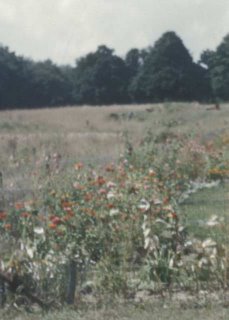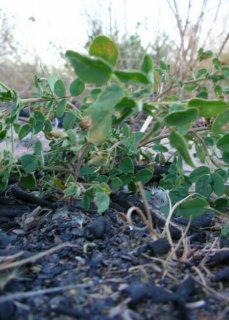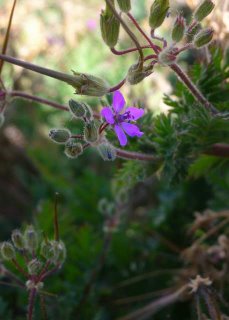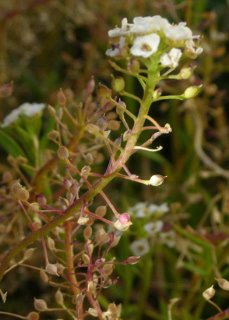 What’s blooming: Sweet alyssum in a pot on the back porch. A bee working a purple aster near the retaining wall suggests the flower is still alive, even though a pinker version of itself.
What’s blooming: Sweet alyssum in a pot on the back porch. A bee working a purple aster near the retaining wall suggests the flower is still alive, even though a pinker version of itself.
What’s green in the area: Honeysuckle, cheese, alfilerillo; grasses, including needle grass and June grass; yucca, yew, juniper, arborvitae, piñon, and other pines.
What’s green in my yard: Snapdragons, columbine, roses, bouncing Bess, large flowered soapwort, sweet peas, sweet white clover, salvia, Romanian sage, thrift, rockrose, winecup, hollyhock, red and blue flax, pink and yellow evening primrose, hartwegia, iris, red hot poker, purple mat plant, catmint, California poppy, vinca, tansy, Frikarti and golden hairy asters, Mexican hat, coreopsis, black-eyed Susan, chocolate flower, perky Sue, mums, yarrow.
What’s grey: Snow-in-summer, pinks, buddleia, yarrow, four-winged salt bush.
What’s red: Raspberry, coral bells, pinks, small flowered soapwort, white, coral and blue beardtongues, cholla.
Animal sightings: Squeaky small brown birds; quail were near the wild area down the road where the ivy-leaved morning glories grew earlier; gopher piled up more dirt.
Weather: Clear days, bright stars; furnace runs more in night; no moisture since 15 October.
Weekly update: I recently published a history of my hometown. Before I started I drew up a list of topics that interested me. Naturally, I included gardens. It was only when I did research that I discovered how difficult it is to reconstruct the past.
It would be sheer luck to discover someone’s growing records, and probably impossible to find them for generations. There were traveler’s accounts and developer’s promotions for particular years that described native vegetation to attract settlers. There were also government statistics on crop yields.
Historians turn to nursery catalogs. But, they only indicate what was available, not what was purchased, and definitely not what grew. In my hometown, the seed companies themselves were interesting, because a man who invested in Ferry Seed also invested in the local farm equipment manufacturer. The artifacts of machinery were easier to trace than the seeds.
The better historic record is pictures, which usually can be dated. In Michigan in the nineteenth century, publishers sent artists to offer to do lithographs that were collected into county directories. In my area, the target audience was farmers, which means the pictures of homesteads include the farmyard layout, barns, animals, and at least some indication of the plants since they were indicators of status.
Early photography required light, so many family pictures were taken outdoors. By chance, the background will show the garden or yard. Even my class reunion picture, taken in 1982, showed contemporary methods of cropping corn, because the interior of the Elks lodge was dim.
People like my father, who took pictures of my mother’s first garden in 1948, were rare. Film and developing cost too much to waste on something as insignificant as flowers.
His faded, slightly out-of-focus slides illustrate the difficulties in identifying plants. The zinnias, marigolds and sweet alyssum are easy to identify by shape and color, as are the cosmos and blue morning glories in other pictures. But there’s a foot high plant with white or lavender flowers I don’t recognize.
I can only guess the large, gray blotches in the foreground are the concord grape I know my mother planted in that corner sometime. I can also surmise from a photograph of her foster mother standing in an arbor why my mother wanted that vine.
Pictures can be misleading. They represent a moment in time, and don’t hint my mother never again planted annuals. The next summer she put in shrub roses and perennials. The permanence of the photograph outlasted her interest.
Rather than documenting the existence of specific plants, photographs and lithographs capture the aesthetic of a time. I look now, not at the garden, but at the trees and grasses growing on what was then fallow farmland and consider how much my taste was formed by that landscape, ephemeral as it was. In a few years, the trees were uprooted for more houses, but today I look out my window in New Mexico on an uninterrupted view of golden grasses, broken by junipers, and feel serene.
It wasn’t just me. Many of my schoolmates grew up in town with a desire to return to that historic landscape. Some bought farms; more moved to local lakes. And, I’m sure with the growth of McMansion style developments, others have bought houses like my parents did that bordered on the past. Some always used the excuse of hunting or fishing to disguise the desire to get away.
I gather from friends here that the same attraction to nature, not as a farm and not as a wilderness, but simply as a latent utopia, exists in the Española valley. It’s not tangible childhood memories that drive us to buy seeds or seedlings in May; it’s a connection with our world formed when we were young that persists when we mature.
Notes: Cameron, the history of a Michigan rust belt town from 1830 to 2006, is available at www.xlibris.com/Cameron.html
 What’s blooming: Except for sweet alyssum in a pot and two purple asters near a wall, the flowers are gone, and along with them, the insects and other animals that fed on them. The active animals have turned to seeds, roots, winter annuals, and evergreens.
What’s blooming: Except for sweet alyssum in a pot and two purple asters near a wall, the flowers are gone, and along with them, the insects and other animals that fed on them. The active animals have turned to seeds, roots, winter annuals, and evergreens.
What’s green in the area: Alfilerillo; grasses, including needle grass and June grass; yucca, yew, juniper, piñon, and other pines. Arborvitae is skimmed in yellow.
What’s green in my yard: Coral beardtongue, snapdragons, columbine, roses, bouncing Bess, large flowered soapwort, sweet peas, sweet white clover, baptista, salvia, Romanian sage, thrift, rockrose, winecup, hollyhock, red and blue flax, pink and yellow evening primrose, hartwegia, iris, red hot poker, catmint, California poppy, vinca, tansy, Frikarti and golden hairy asters, tahokia daisy, Mexican hat, coreopsis, black-eyed Susan, chocolate flower, perky Sue, wild lettuce, mums, yarrow.
What’s grey: Snow-in-summer, pinks, buddleia, yarrow, four-winged salt bush.
What’s red: Barberry, coral bells, pinks, small flowered soapwort, white and blue beardtongues, cholla.
Animal sightings: A few surviving grasshoppers; birds around fence and trees; gopher dug more dirt near the sour cherry; something knocked bricks from the lining walls along the garden.
Weather: Clear days, bright stars, no moisture since 15 October.
Weekly update: Saturday was burn day in the valley. I saw five plumes of smoke along the main road in the morning, and noticed two others collecting dead weeds for pyres.
The man behind me at the post office said he was ready to burn his fields, which he likes to do every two years to eliminate mats. The grass comes back and the alfalfa’s not harmed.
I’m much more conservative about burning, probably because I come from Michigan where we were trained to build rock circles around cook fires. At one summer camp, the leader made us line the bottom as well, lest we ignite the peat. That seemed extreme to this teenager, but I’ve been told a peat fire has been smoldering northeast of town for several years.
On a still, cloudy day this July I found a place in my drive that was wet and laid down a long cardboard box that had held a sapling. I piled old financial papers in the box, turned on the hose and lit a match.
While the papers were burning, I cut down 5' high white sweet clover plants from last summer and fed them to the flames. Then I added other dead plants from the drive and rosewood cuttings I hadn’t taken out yet for the trashmen.
As the fire burned, plants in the area would catch. I protected the asters and grasses, but let the rest go, the yellowbrush, winterfat and clover that had invaded the gravel. I rather hoped the heat would kill them.
I’m quite willing to let white sweet clover grow in the yard, but its branches scratch the fence when they dry in winter. Unfortunately, Melilotus Alba needs water and chooses my garden. Yellow sweet clover, Melilotus Officinalis, is the one that grows along the shoulders until it’s mown down in late summer before it reaches its full height.
When I got home yesterday I saw the clover still growing amid the charred remains in my drive. The European native thrives on fire, and only starts to die out when prairie fires stop and other plants take its resources. With no water, it can die out in three years.
I was fooled by the grasshoppers that chomped last year’s biennial seedlings. It was easy to cut any stalks before the spikes of tiny white flowers appeared. But, as soon as it rained in July, old seeds sprouted.
Rain is protective as well as nutritive. The taproots are long; I’ve pulled some that were close to 3' long. They can only be removed when the ground is wet, which is often when it has already produced its tiny seeds. The trefoil seedlings are tedious to pull and impossible to poison in the rain.
White sweet clover was officially introduced into this country by Henry Tutwiler who imported seed from Chile to grow at Green Springs Academy in Alabama in 1856. The legume’s roots add nitrogen and humus to the soil. Animals graze the plants in early spring and eat hay that has been cured enough to dissipate the bitter coumarin.
I assume the rancher prefers alfalfa for his horses. He complained someone from Colorado was peddling hay that horses wouldn’t eat and contained tumbleweed seeds. When I suggested it might work as straw, he said no, not with those seeds. Had to be burned.
Notes: United States Department of Agriculture, Forrest Service, Range Plant Handbook, 1937, republished by Dover Publications, 1988.
 What’s blooming in the area: A few blanket flowers survive along my neighbor’s drive. Leaves dropping, cottonwoods and apples turned brown or bare.
What’s blooming in the area: A few blanket flowers survive along my neighbor’s drive. Leaves dropping, cottonwoods and apples turned brown or bare.
What’s blooming in my garden: Fading chrysanthemums, sweet alyssum vital in porch pot.
Animal sightings: Nothing when I’m looking.
Weather: Clear days, bright stars, no moisture since 15 October.
Weekly update: Something purple was blooming on dense, ferny plants at my neighbor’s fence last weekend.
The five petaled flowers splayed in loose round umbrels and long, tapering seed capsules looked like something from the geranium family. Field guides tell me it could be Erodium Ciculatium, which goes by the not-so common names Filaree, Pin Clover, and Red-Stemmed Filigree. Europeans call it Common Cranesbill.
How it got to my uphill neighbor’s yard is guesswork. Spain introduced the Mediterranean annual to México and Chile. Mensing and Byrne analyzed pollen in Santa Barbara basin sediments to show it reached California at least a decade before the missions, and probably crept north from Baja. It could have landed here with settlers anytime after Oñate wintered north of town in 1589, or diffused from settlements and missions to the south.
The migration mechanism is simple: cranesbill’s sharp carpels stick to passersby, especially furry ones. Today it’s not only grazed by cattle and sheep, but mule deer, elk and pronghorn. Rabbits clear room when they gnaw competing perennial grasses. Deer or rabbits could have been the exozoochoric agent that moved seeds before cattle or sheep escaped.
Once in the soil, the desert colonizer germinates whenever daily air temperature ranges are warmer than 40 to 69 degrees, and there’s enough moisture. This summer it was blooming in my neighbor’s yard August 16, some forty days after the first summer rains. It adapts to drying soil by accelerating its maturation cycle to produce seed quickly, again as it has done next door where it’s blooming in the fall, rather than wintering over and blooming early next year.
How the seed moved from someplace like Anadalusia or Estremadura is more speculation. Most historians assume it was accidental, that it came with the food or accouterments of animals, might even have been in the wool of sheep. Others suggest the 1/16"-1/8" elliptical, brown seed could pass for wheat.
If instead the importation was deliberate, it might have been for medicine. Curtin found alfilerillo used for gonorrhea in Northern New Mexico in the 1940s. A contemporary Argentinian herbal suggests it’s useful for blenorragias, roughly translated as female gonorrhea. In 1987, Polish scientists established it is effective against Herpes virus type 1.
Modern herbals usually repeat it’s hemostatic, but Lust specifies storkbill’s uses for bloody uterine discharges and excessive menstruation. Gohar reports it has been used to induce uterine contractions, while a northern Mexican herbal explicitly suggests the leaves induce abortions.
Sexually transmitted diseases and female problems, whatever that euphemism denotes, certainly existed for early colonists, and familiar yerba seeds would have been brought by women who became curanderas. The French still call it peine de la bruja (witch’s comb.) More than likely, such things would not have appeared in records kept by literate priests or administrators.
All of which is interesting, but doesn’t much explain why its growing next to my drive. Since it often stays low, especially if it’s cropped or mown, and the flowers open mid-morning, it could be lurking along the road unseen. More likely, my previous neighbor imported the seeds with his wood pile or horses’ hay.
If it’s true a single plant can produce 2,400 to 9,900 seeds and its deep taproot deprives its neighbors of water, I hope my neighbor overlooks it and lets it multiply to intimidate the nastier pigweed and Russian thistle that thrive on his land.
Notes:
Argentina. "Alfilerillo," at Hipernatural.com.
Curtin, L. S. M. Healing Herbs of the Upper Rio Grande (1947), revised for Western Eagle Press by Michael Moore (1997).
Gohar, Ahmed A., Mohammed F. Lahloub, and Masatake Niwa. "Antibacterial Polyphenol from Erodium Glaucopyllum," Zeitschrift für Naturforschung 58:670-674:2003.
Lust, John B. The Herb Book (1974).
Mensing, Scott and Roger Byrne. 1998. "Pre-Mission Invasion of Erodium Cicutarium in California," Journal of Biogeography 25:757-762:1998.
Mondragón Pichardo, Juana. "Erodium cicutarium (L.) L'Her. ex- Ait.," 2004, revised by Heike Vibrans, 2005, available on-line..
Zielinska-Jenczylik J., A. Sypula, E. Budko and H Rzadkowska-Bodalska H. "Interferonogenic and Antiviral Effect of Extracts from Erodium Cicutarium," Archivum Immunologiae et Therapiae Experimentalis 35:211-20:1987.
 What’s blooming in the area: If anything’s still blooming, it’s in some protected place hidden from the road. One man burned piles of weeds Saturday; most have left things as they are.
What’s blooming in the area: If anything’s still blooming, it’s in some protected place hidden from the road. One man burned piles of weeds Saturday; most have left things as they are.
What’s blooming in my garden: Chrysanthemums, sweet alyssum, one blanket flower, single flower atop a yellow snapdragon spike.
Animal sightings: Flock of nondescript, middling small birds looked like clothes pins on power line last Sunday. During week, I scared up groups of birds from Maximilian sunflowers in mornings. Horses in village.
Weather: Frost Monday morning killed any remaining f lowers; rest of week, sunny, cool and dry. Last noticeable rain, 15 October.
Weekly update: Mustard is one of the first plants to arrive in spring, and one of the last to depart come fall.
Tansy mustard (Descurainia Pinnata) emerges the end of March and puts out its feeble, yellow-green flowers a month later. I yank the distinctive grey-green plants when they emerge along the retaining wall, So far, the southwestern native hasn’t found favorable conditions in the yard. It remains a harbinger, not a nuisance.
Tumble mustard (Sisymbrium Altissimum) is more attractive when it takes over fields and roadsides in mid-May. Fortunately, the invasive annual hasn’t appeared here yet, but the clear yellow flowers continued in my uphill neighbor’s yard until August, producing pregnant seed pods. Its early rosette, similar to a thistle, is easy to identify, and so it should be possible to keep it at bay if it threatens to migrate.
With so many unwanted volunteers from the Cruciferae family, you’d think Sweet Alyssum would be a natural in my alkaline, clay loam. Not so.
When I first tried, soon after moving here, the bedding plants died the day I transplanted them, the seed disappeared. I dropped seed in pots on my back porch with morning glories. They bloomed just enough to continue buying them, even though the tiny seedlings drowned when I watered them, then died when the summer sun no longer reached them.
Two years ago, I noticed morning glory seeds had blown over the retaining wall and deposited themselves where the tansy mustard grew. Last year, I broadcast the cayenne-colored, oleaginous seeds there, then got impatient, and added plants. They both did so well the flowers survived the mild autumn until after Thanksgiving.
This year, I scattered Carpet of Snow on half-day snow March 13. I bought packs of New Carpet of Snow April 15, then added leftover generic seed from 2005 on April 22. Seedlings started blooming June 24.
Plants and seeds of Lobularia maritima behave differently. Breeders select varieties which retain their compact habit, and probably use techniques that encourage flowers and discourage stems. The seeds I use are the older, leggier versions that quickly form long stems with small flower heads. Many side branches remain from departed seeds that resemble utility pole cleats.
They looked good in spring before anything else was blooming, then got messy when bare, colorless stems dominated the mats of white flowers. By then, I didn’t care because there were so many other things to see, I could afford to let them be. This year, as the cool season dragged on, even the bedding selections elongated. But still I didn’t care because the nearby marigolds were spectacular. The kelly green leaves masked dry, bare ground, and occasionally the sweet scent could be detected on damp mornings.
Now they’re all that’s left. In November you ask very little of a flower that blooms this late. They may be native perennials along the Mediterranean, but here they'll die when temperatures fall below their zone 7 tolerance. Until then, they repay benign neglect with endurance.
 What’s blooming: Sweet alyssum in a pot on the back porch. A bee working a purple aster near the retaining wall suggests the flower is still alive, even though a pinker version of itself.
What’s blooming: Sweet alyssum in a pot on the back porch. A bee working a purple aster near the retaining wall suggests the flower is still alive, even though a pinker version of itself.

